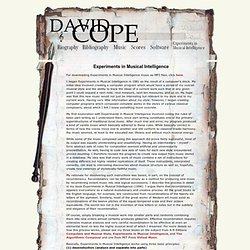

The Ring and I - Wagner. On this Radiolab/WNYC Special, we explore the impact and influence of Wagner's Ring Cycle on the Metropolitan Opera's 2004 Presentation.

It might seem hyperbole to claim, as many Wagnerites do, that The Ring Cycle is 'The Greatest Work of Art Ever.' But the grandeur and power of this monumental work have permeated our culture from Star Wars to Bugs Bunny to J.R.R. Tolkien. Musical Language. In this hour of Radiolab, we examine the line between language and music.

What is music? Why does it move us? How does the brain process sound, and why are some people better at it than others? We re-imagine the disastrous debut of Stravinsky’s Rite of Spring in 1913 through the lens of modern neurology, and we meet a composer who uses computers to capture the musical DNA of dead composers in order to create new work. Musical DNA. David Cope - Experiments in Musical Intelligence. For downloading Experiments in Musical Intelligence music as MP3 files, click here.

I began Experiments in Musical Intelligence in 1981 as the result of a composer's block. My initial idea involved creating a computer program which would have a sense of my overall musical style and the ability to track the ideas of a current work such that at any given point I could request a next note, next measure, next ten measures, and so on. My hope was that this new music would not just be interesting but relevant to my style and to my current work. Having very little information about my style, however, I began creating computer programs which composed complete works in the styles of various classical composers, about which I felt I knew something more concrete. My first exploration with Experiments in Musical Intelligence involved coding the rules of basic part-writing as I understood them, since part writing constitutes one of the primary superstructures of traditional tonal music.
The Rite of Spring. The Rite of Spring (French: Le Sacre du printemps, Russian: «Весна священная», Vesna svyashchennaya) is a ballet and orchestral concert work by the Russian composer Igor Stravinsky.

It was written for the 1913 Paris season of Sergei Diaghilev's Ballets Russes company; the original choreography was by Vaslav Nijinsky, with stage designs and costumes by Nicholas Roerich. When first performed, at the Théâtre des Champs-Élysées on 29 May 1913, the avant-garde nature of the music and choreography caused a sensation and a near-riot in the audience. Although designed as a work for the stage, with specific passages accompanying characters and action, the music achieved equal if not greater recognition as a concert piece, and is widely considered to be one of the most influential musical works of the 20th century.
Background[edit] Synopsis and structure[edit] The French titles are given in the form given in the four-part piano score published in 1913. Creation[edit] Conception[edit] Premiere[edit] Riot at the Rite. Igor Stravinsky - The Rite of Spring. Igor Stravinsky - Le Sacre du Printemps - Vaslav Nijinsky-Version 1913 - Ballett Mariinski-Theater. Sometimes Behaves So Strangley. Diana Deutsch - Illusions and Research. Introduction The following entries describe and illustrate some of Deutsch’s illusions of music and speech.

Many of them show that people can differ strikingly in the way they hear very simple musical patterns. These disagreements do not reflect variations in musical ability or training. Even the finest musicians, on listening to the stereo illusions described here, may disagree completely as to whether a high tone is being played to their right ear or to their left. And the most expert musicians, on listening to the tritone paradox, can engage in long arguments as to whether a pattern of two tones is moving up or down in pitch.
How do we explain these striking perceptual discrepancies? Another theme that runs through these illusions concerns relationships between music and speech. The illusions described here lead us to wonder what other curiosities of music perception might exist that have not yet been discovered. Technical Listening Notes. Pop Music. Loops. Our lives are filled with loops that hurt us, heal us, make us laugh, and, sometimes, leave us wanting more.

This hour, Radiolab investigates the strange things that emerge when something happens, then happens again, and again, and again, and again, and again, and … well, again. In this episode of Radiolab, Jad and Robert try to explain an inexplicable comedy act, listen to a loop that literally dies in your ear, and they learn about a loop that sent a shudder up the collective spine of mathematicians everywhere. Finally, they talk to a woman who got to watch herself think the thought that she was watching herself think the thought that she was watching herself think the thought that ... you get the point. All that plus mind-bending musical accompaniment from Laguardia Arts High School singers Nathaniel Sabat, Julian Soto, Eli Greenhoe, Kelly Efthimiu, Julia Egan, and Ruby Froom.